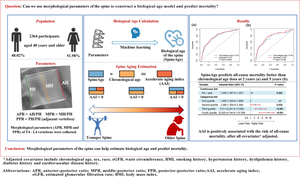GeroScience ( IF 5.3 ) Pub Date : 2024-10-24 , DOI: 10.1007/s11357-024-01394-8 Zi Xu, Yunsong Peng, Mudan Zhang, Rongpin Wang, Zhenlu Yang

|
Accurately estimating biological age is beneficial for measuring aging and predicting risk. It is widely accepted that the prevalence of spine compression increases significantly with age. However, biological age based on vertebral morphological data is rarely reported. In this study, a total of 2,364 participants from the National Health and Nutrition Examination Survey were enrolled, and morphological parameters of the spine were collected from lateral radiographs scanned by dual energy X-ray absorptiometry. The biological age of the spine, called SpineAge, was calculated with the parameters by machine learning models. The SHapley Additive exPlanation was used for better interpreting each parameter's contribution. Besides, an Accelerated Aging Index (AAI) was defined as SpineAge minus chronological age and was used to quantify the accelerating aging degree of the spine. The results indicated that the SpineAge performed better than chronological age did in predicting 2-year and 5-year all-cause mortality. After adjusting all covariates, there was a significant association between AAI and all-cause mortality risk. Specifically, each 1-year increase in AAI was associated with a 25.9% increase in all-cause mortality risk (Hazards ratio, 1.259; 95% CI, 1.087–1.457; P < 0.001). Considering the first quartile of AAI as a reference, the mortality risks for the second, third, and fourth quartiles were 2.389 (95% CI, 1.064–5.364; P = 0.035), 5.911 (95% CI, 2.241–15.590; P < 0.001) and 22.925 (95% CI, 4.744–110.769; P < 0.001) times higher, respectively. Our study developed a novel and highly applicable biological-age predictor for predicting individualized long-term prognosis and facilitating personalized care.
Graphical Abstract
中文翻译:

一种基于脊柱形态参数的可解释机器学习估计生物年龄
准确估计生物年龄有利于测量衰老和预测风险。人们普遍认为,脊柱压迫的患病率随着年龄的增长而显着增加。然而,基于椎体形态学数据的生物年龄很少报道。在这项研究中,共有 2,364 名来自全国健康与营养检查调查的参与者入组,并从双能 X 射线吸收测定法扫描的侧位 X 光片中收集脊柱的形态参数。脊柱的生物年龄称为 SpineAge,由机器学习模型使用参数计算得出。SHapley 加法解释用于更好地解释每个参数的贡献。此外,加速衰老指数 (AAI) 定义为 SpineAge 减去实际年龄,用于量化脊柱的加速衰老程度。结果表明,SpineAge 在预测 2 年和 5 年全因死亡率方面优于实际年龄。调整所有协变量后,AAI 与全因死亡风险之间存在显著关联。具体来说,AAI 每增加 1 年,全因死亡风险就会增加 25.9%(风险比,1.259;95% CI,1.087-1.457;P < 0.001)。以 AAI 的第一个四分位数作为参考,第二个、第三个和第四个四分位数的死亡风险为 2.389 (95% CI,1.064–5.364;P = 0.035),5.911(95% CI,2.241–15.590;P < 0.001) 和 22.925 (95% CI, 4.744–110.769;P < 0.001) 倍。我们的研究开发了一种新的且高度适用的生物年龄预测因子,用于预测个体化的长期预后并促进个性化护理。


















































 京公网安备 11010802027423号
京公网安备 11010802027423号